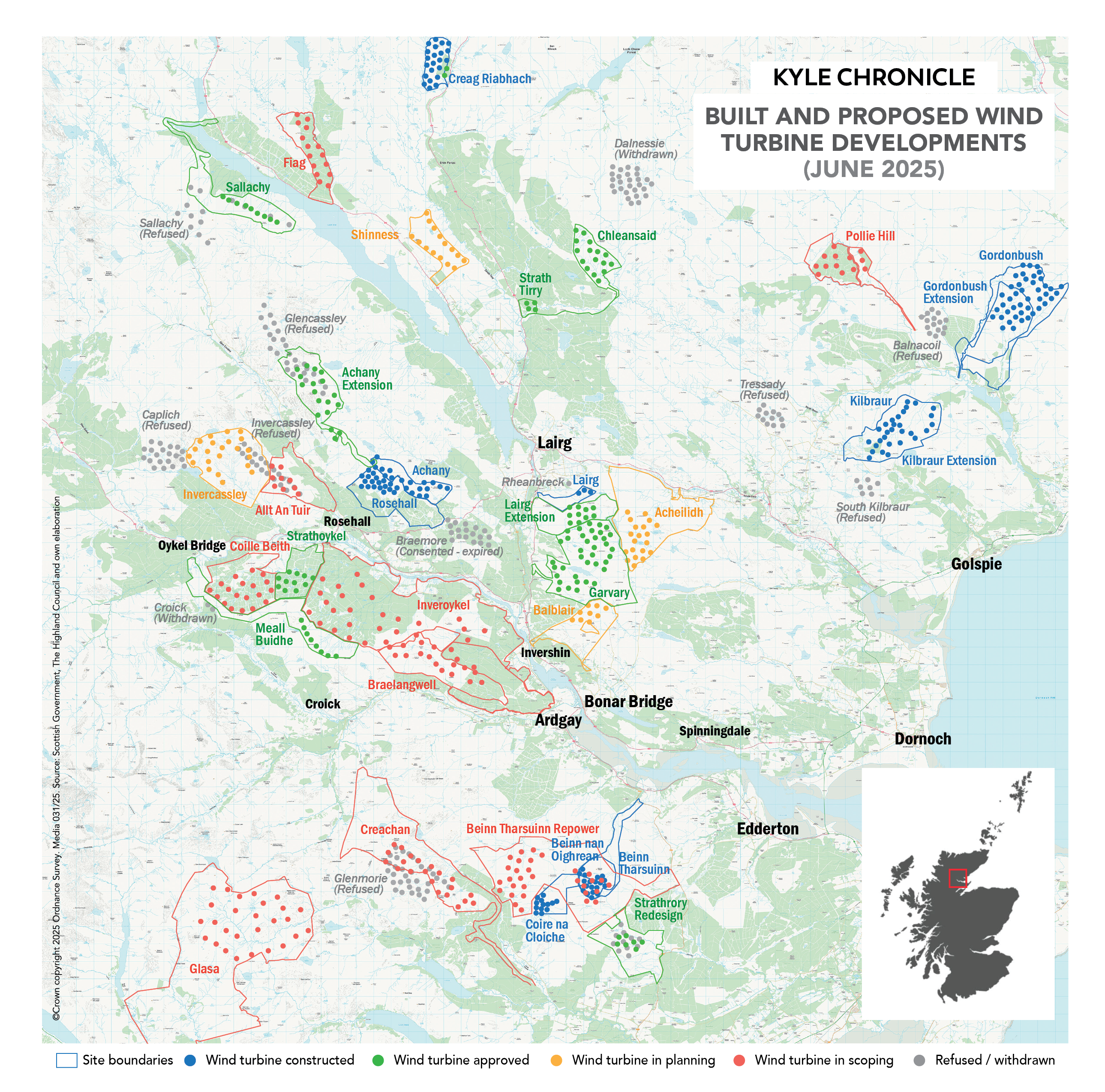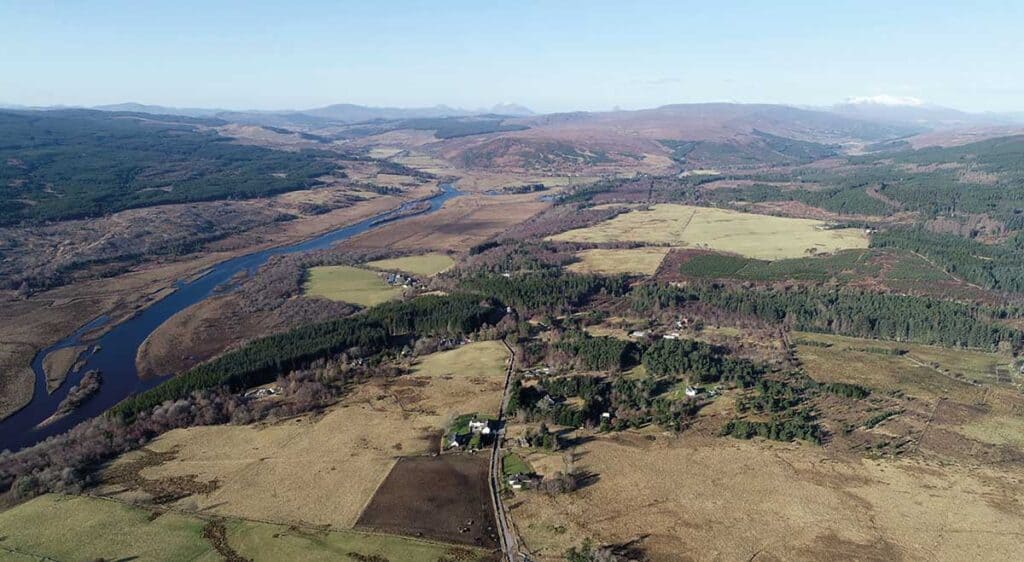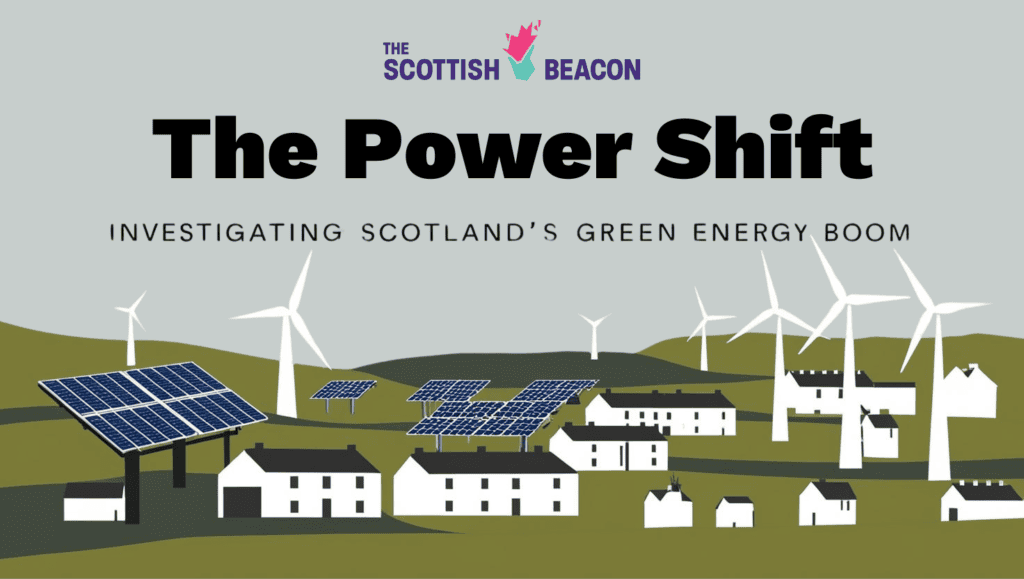“It seems [Scottish Ministers Alastair Allan and Gillian Martin] are completely detached from the reality of what is being faced here in the broadest terms, which at the last count is 171 turbines, 100 of them 200m or over, plus BESS installations, plus a 23-hectare solar array, […] in a rural landscape, adjacent to a Significant Area of Conservation, Sites of Special Scientific Interest, a Special Protected Area and wild land. It is hard not to feel completely detached from Government. The process of local democracy is not being listened to.” Tisi Dutton’s opening remarks at a well-attended meeting held in Ardgay between Maree Todd and her constituents on 9th May mirror what many are now voicing in our communities.
The meeting, organised by No Ring of Steel – Kyle of Sutherland (NORoS), touched on a variety of subjects, including cumulative impact, standing charges, compulsory purchase orders, constraint payments, adherence to National Planning Framework 4 (NPF4) and the effects on mental health faced by members of the community “as they grapple with the relentless flow of wind farm applications, appeals and reapplications”. While campaigners saw their proposal of a meeting with the Cabinet Secretary for Net Zero & Energy, Gillian Martin, and the Minister for Climate Action, Alasdair Allan declined, as “it would be seen as prejudicial to the outcome of the planning process”, Maree Todd agreed to pursue the idea of a meeting with CC members.

A spokesperson for NORoS, said: “NORoS is disappointed that Government ministers are unwilling to engage with us over the pressure experienced by our local communities enduring a relentless barrage of new and ever larger wind, solar and BESS proposals. We believe that plans to build up to 171 turbines within an area just 10 miles by 2 miles are excessive, and that a planning system which allows this process to continue without checks or limits breaches the government’s responsibility to its citizens and to the natural environment.
“If ministers will not engage with us, they could surely meet our elected community councillors from the Kyle of Sutherland. It is essential that, as part of the democratic process, communities are represented in the planning process and that politicians appreciate the scale of what is happening. The Minister for Public Finance has stated that ‘The decision-making process hinges on the quality and validity of objections’. These criteria are not fully transparent at present and should be made explicit to assist local communities in maximising their representations.”
Speaking about these concerns, Maree Todd MSP Caithness, Sutherland & Ross, said: “I’m a strong supporter of clean, green energy and the benefits it can bring– not just for the climate, but for our communities and the economy too. That said, I’ve always been clear that developments need to happen in the right places, and local voices absolutely have to be heard.
“NPF4 is a policy that gained cross-party support, although it was brought forward by the Scottish Government, it gained support from Labour, the Greens and the Lib Dems. Only the Conservatives opposed it. Under NPF4, things like the impact on local communities, the environment, and the landscape all need to be properly taken into account when decisions are being made.”
“Planning decisions are made through a quasi-judicial process, which means they must follow the law and the rules set out in planning legislation. MSPs can’t intervene or influence the outcome of individual applications. When councillors or Scottish Ministers make a decision, they have to apply the law as it stands and assess each case within that legal framework.
“I know there are local concerns about how the policy is being applied, especially around things like cumulative impact, and I’m raising these directly with the Scottish Government and pushing for clearer guidance.”
The Planning Process
Consent for electricity works including above ground electric lines and electricity generating stations with a capacity greater than 50MW is given by Scottish Ministers via the Energy Consents Unit under the Electricity Act 1989; if they don’t meet these criteria, they are considered under the Town and Country Planning (Scotland) Act 1997, and are usually a matter for the relevant planning authority, in our case The Highland Council. Where planning permission is required for development which is classed as ‘national’ or ‘major’ development, applicants are required to undertake formalised pre-application consultation with communities.
When making considerations, planners need to weigh what is “material” and relevant, defined as what should serve or be related to the purpose of planning, and what fairly and reasonably relates to the particular application. Planning framework (eg. NPF4), views of statutory and other consultees, and Scottish Government and UK policy are on the top of the list of material considerations, alongside others such as visual appearance, environmental impact, archaeology, nature conservation, listed buildings, nuisance (noise, smell, fumes…), adverse safety impact, compatibility with existing uses, economic benefits, and suitable access and transportation.
Items that are not considered material considerations include:
- private impacts on 3rd party (eg. devaluation of property);
- private interests (eg. loss of a view);
- moral or religious considerations;
- political considerations or ideological dislikes;
- cost of the development and financial means of the applicant;
- issues covered by other legislation (eg. health & safety, licensing).
Some of the NPF4 policies that are discussed surrounding renewable energy planning applications are:
Natural Places Policy 4: “a) development proposals which by virtue of type, location or scale will have an unacceptable impact on the natural environment will not be supported”. However, it includes exceptions to approving projects affecting National Scenic Areas, Sites of Special Scientific Interest or Natural Nature Reserves “if the overall integrity of the areas will not be compromised, and if “it’s outweighed by social, environmental or economical benefits of national importance.”

NPF4 Policy 5 (Soils) aims to “protect carbon-rich soils, restore peatlands and minimise disturbance to soil from developments”, and proposals on peatlands can only be supported if it’s for “essential infrastructure and there is a specific locational need and no other suitable site” and for “the generation of electricity from renewable sources that optimises the contribution of the area to greenhouse gas emissions reductions targets”. They are also subject to a detailed specific assessment.
Regarding Energy, Policy 11 states: “Development proposals for all forms of renewable, low-carbon and zero emissions technologies will be supported.” There are, however, some exceptions: “Development proposals for wind farms in National Parks and National Scenic Areas will not be supported.” And “Development proposals will only be supported where they maximise net economic impact, including local and community socio-economic benefits such as employment, associated business and supply chain opportunities.” Project design and mitigation will demonstrate how a series of impacts are addressed (from visual impact, noise and shadow flicker, landscape, public access, impacts on aviation, defence, telecommunications, road traffic, historic environment, hydrology, water environment, flood risk, biodiversity – including impact on birds, trees, woods and forests, proposals for the decommissioning and site restoration, and cumulative impacts. “Where impacts are localised and/or appropriate design mitigation has been applied, they will generally be considered to be acceptable.”
In practice, and as a result of these thorough assessments, most applications now have around 250 documents (which may mean several thousand pages), and that excludes comments from consultees and other documents, which can easily raise the number to 400 documents per application.
The volume, but also the complexity of the documents themselves, seem to be a barrier for community participation in the planning process. Residents are saying, for example, that “noise assessments just look like numbers in a table. Unless you can read and have an understanding of what they mean, it’s just like a foreign language.”
Some councils are asking that anyone seeking planning permission must declare whether AI was used to help create any documents supporting their application. Although applicants are not required to declare their use of traditional AI technology such as grammar and spellcheck functions, North Norfolk Council Planning warns that some large language models (LLM) have “been trained to produce longer answers to demonstrate their intelligence”, and that this can produce “AI-driven bulking” which can “adversely impact the ability of decision makers to reach conclusions on planning” and will “likely have an adverse impact on the public’s ability to participate in the planning process”.
Cumulative impact & maps
There are now several online maps for local people to track energy developments: The Highland Council’s wind turbine map (typically updated twice a year) on https://www.highland.gov.uk/info/198/planning_-_long_term_and_area_policies/152/energy_projects/4
The Energy Projects map, pushed for by Councillor Helen Crawford, that went live on 30th April: https://www.highland.gov.uk/info/198/planning_-_long_term_and_area_policies/152/energy_projects
And finally, The Scottish Parliament Information Centre’s map: https://spice-spotlight.scot/2024/06/17/renewable-energy-map-of-scotland/
Community Benefit
The Scottish Government Guidance on good practice principles for community benefits from onshore renewable energy sets the expectation of £5,000 per installed megawatt per annum, index linked for the operational lifetime of the project. However, these are voluntary arrangements, not considered a material factor in determining whether or not to grant planning permission.
But this might change. The UK Government has published a working paper (closing date 16th July) in which it is considering mandating the provision of community benefit funds for low carbon energy infrastructure. This, they say, would create a level playing field across developers and communities, ensuring consistency and fairness in application.
The Kyle of Sutherland and surrounding area have been attracting renewable energy generation developers since the early 2000s, with the first planning applications received in 2003. Over two decades later, there are 11 operating wind farms, 10 projects that have been granted planning permission, and another 13 wind farm development projects in planning or scoping.
Wind farms are not the only proposed renewable projects around our area. There is a large operating hydro scheme (Shin), plans for a Cromarty green hydrogen plant near Edderton, a recently approved biogas anaerobic digester plant near Tain, plans for a solar array in Allt an Tuir (Rosehall), and several energy storage systems (BESS), either in conjunction with wind farm developments, or on their own (West Saval, Lairg, Clynelish).
In addition, the area in one of the “nodes” of the SSEN transmission 400kW overhead line Path to 2030, which will see 60m pylons crossing the Kyle and the straths, and a new substation (Carnaig) beside the existing one at Loch Buidhe. The project is to connect Spittal in Caithness with Beauly and Denny, with onshore developments feeding in along the way.


This article is part of The Power Shift – a collaborative investigation by 10 independent, community-based publishers across Scotland, exploring the impact of the green energy transition on communities. Co-ordinated by the Scottish Beacon and supported by the Tenacious Journalism Awards, the project aims to amplify local voices, facilitate cross-community learning and push for fair, transparent energy development.

